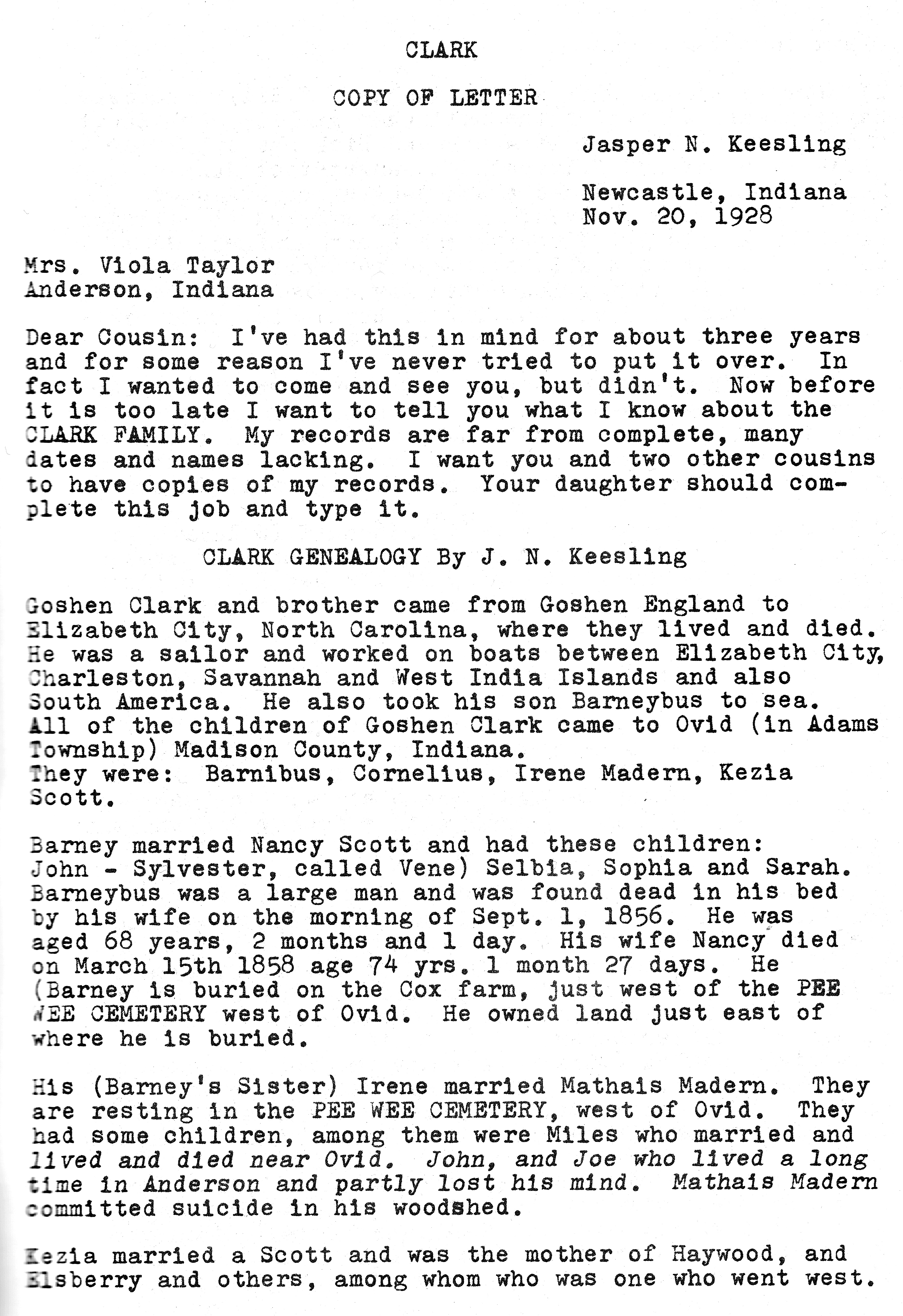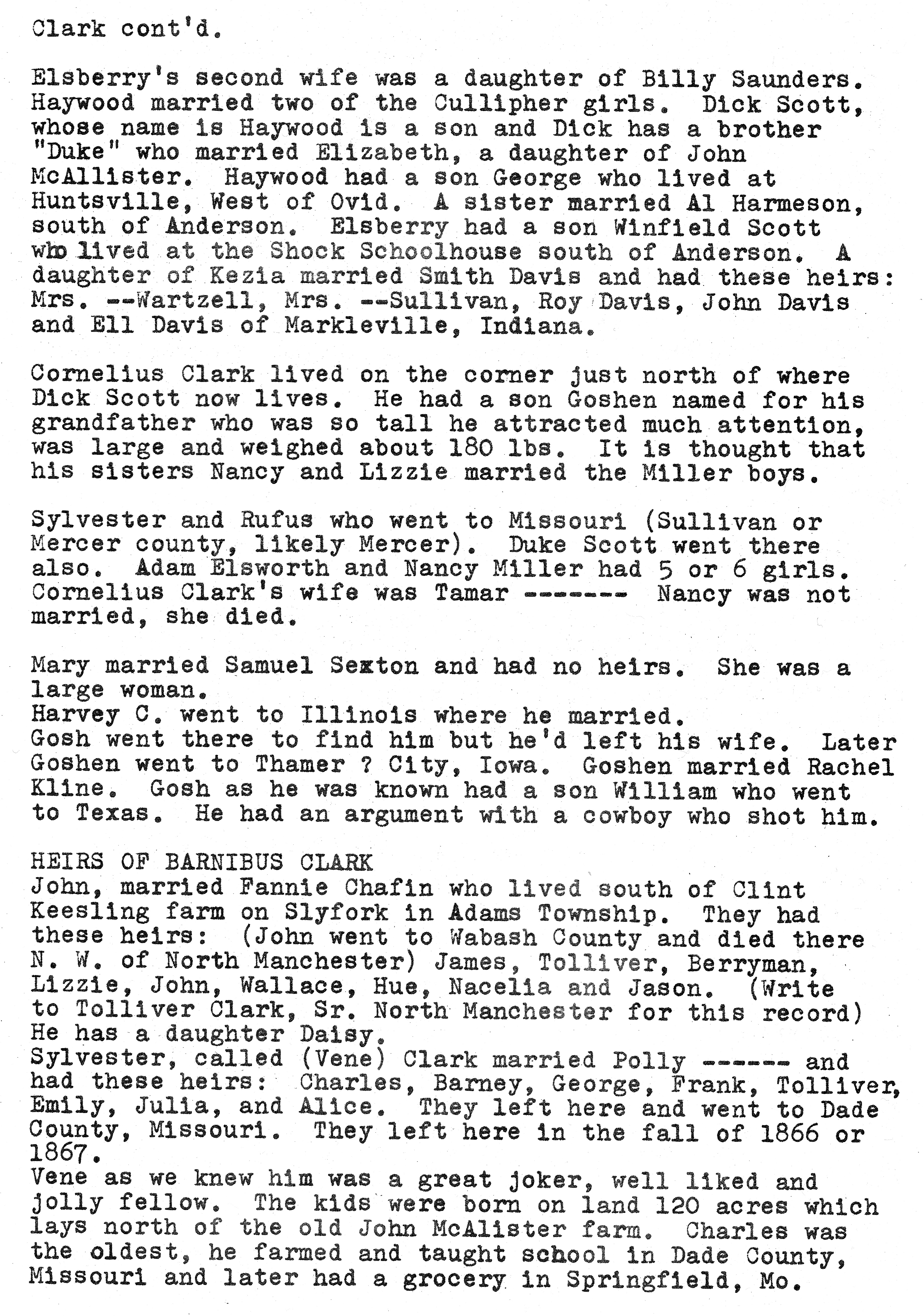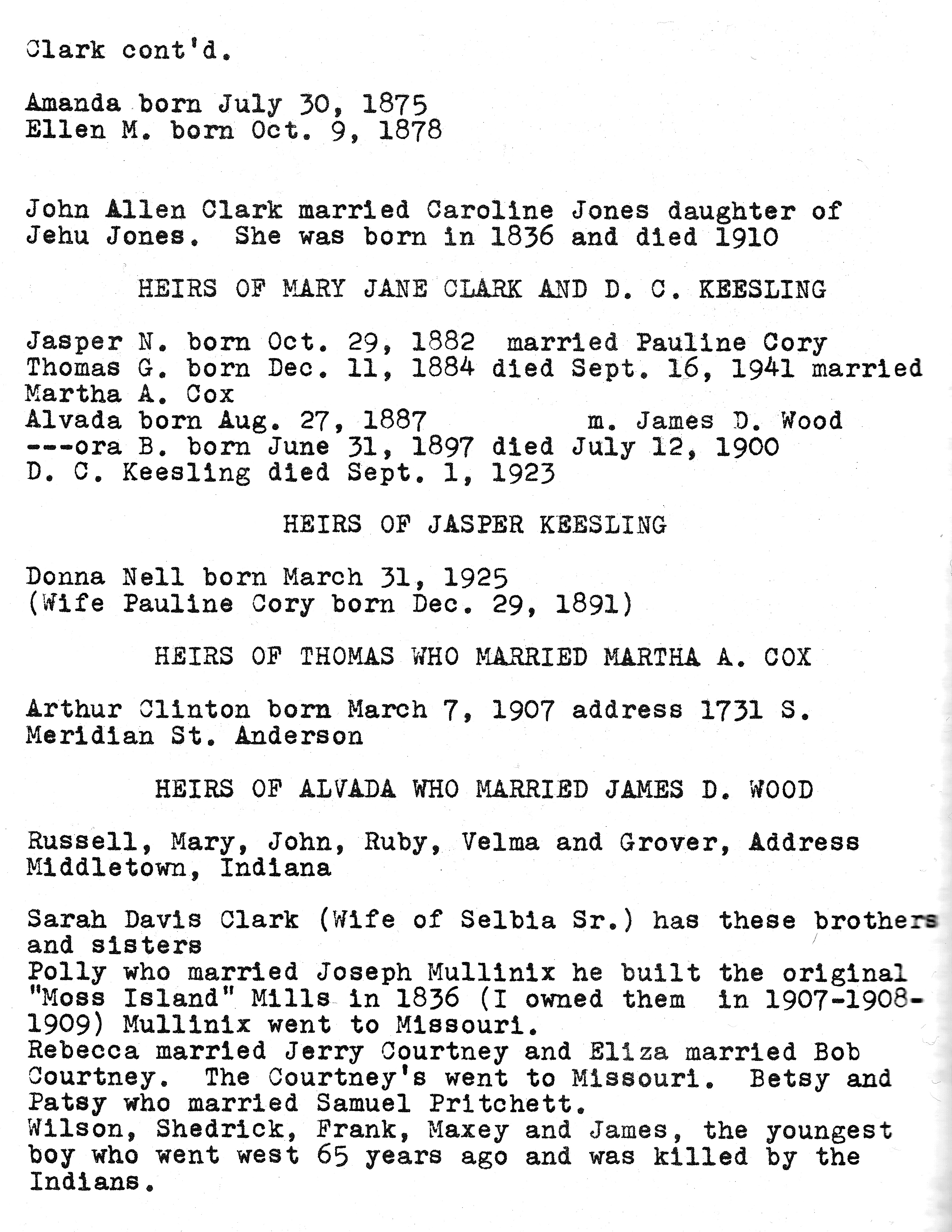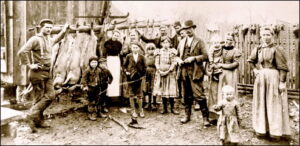The Clark Ancestors of Lloyd J. Stohler
And their Madison County Relation
In the early decades of its development
In the State of Indiana and
As a State of the United States
My ancestor Clarke family came to Albermarle Sound, North Carolina. There were two immigrant brothers: Goshen, my ancestor, and Cornelius. Both brothers settled in Pasquotank County near Elizabeth City in Elizabeth Township. A grove of trees near Elizabeth City is still known as the “Clarke Grove”, named after Goshen. The exact date and port of entry they entered, I do not know; but they are both included in the 1790 First Census.
Family legend spells the surname as C-l-a-r-k-e. I possess a reproduction of a letter written by Winfield Scott that states the Scott families and Clarke families came to Pasquotank County from Scotland originally, and that all the old men were sailors before settling in North Carolina.
My great-great Grandfather, Barnabus Clarke, appears in the early censuses of North Carolina, and in the 1840 census in Indiana with the surname spelled Clarke.
Goshen Clarke, father of Barnabus, was my immigrant ancestor of my Mother, and his wife was Sallie Pritchard. They were the parents of eight children, and I am a descendant of their son, Barnabus, born 31 July 1783.
Goshen was a sailor and worked on boats between Elizabeth City, Charleston, Savannah, the West Indies, and South America. Goshen bought a farm in Pasquotank County near Elizabeth City.
As a young man, Barnabus was a sailor and he was captured by the British Navy and held a prisoner for about six months during the United States and British War of 1812.
Barnabus Clarke married Nancy Scott, and she was born 18 April 1784. They had nine children. One boy, Selbia Harvey Clarke, born 12 June 1809, is my Great Grandfather. I am fortunate to possess his old family Bible.
Selbia came to Indiana when a young man. He obtained a marriage license at Wayne Circuit Court, Wayne County, Indiana, to marry Sarah Anne Davis, 16 April 1831. They were married by Joseph Curtis, Justice of the Peace, 17th day of April 1831. They settled in Adams Township, Madison County, Indiana. I do not know whether they returned from Madison County to Wayne County in order to obtain their marriage license or possibly the marriage took place on their way to Madison County. However, the Davis family of Sarah Anne also settled in Adams Township, Madison County. Selbia found employment in building some of the early canals in Indiana.
The parents of Selbia, Barnabus and Nancy (Scott) Clarke, came to Indiana in the early 1830 years and settled in Adams Township, Madison County. Many of their children came with them. Also several brothers and sisters of Barnabus came to Adams Township, Madison County.
Ephriam Clarke, son of Cornelius, moved his family from North Carolina to Madison County. Likewise many Scott relatives of Nancy came to Madison County.
Selbia and Sarah Anne were parents of fourteen children. One son was Francis Marion, born 29 January 1849. He married Mary Magdalene Hoppes 19 June 1860. My Mother, Mary Anne, was their daughter, and was born in Madison County 21 January 1875.
Barnabus and Selbia purchased land in Adams Township Madison County. Barnabus purchased a farm ½ mile south of New Columbus beginning at the Pee Wee Cemetery and west about ½ mile. Selbia purchased land north and east of New Columbus located about 3 ½ miles directly north of Markleville.
The old Cox Farm, west of New Columbus, is the location of the Jackson Cemetery. Barnabus and Nancy were buried there. Also Thamar, wife of Cornelius, and members or other Clark families, Cullipher families, Michael families, and Sexton families. In recent years, a man by the name of Wellington bought the ground because in contained a good deposit of gravel. He proceeded to open a deep trench, and buried the bones of the occupants and their memorial stones in the trench and covered them all with dirt. My wife, daughter mary, and a second cousin, Walther Stohler. Visited this cemetery about 196?. Only two children’s memorial stones were left: that of James H. Cullipher, son of James and Jeanette Cullipher, and the stone of the infant son of Sylvester and Polly (Mary) Clark.
Selbia and Sarah Anne were the parents of fourteen children. Barney, the eldest child, was blind most of his life and spent much of his lifetime in darkness. He could distinguish night from day. He lived much of his adult life in the home of his brother, Robert Henry Clark. Robert had installed ropes to the barn and other buildings, which Barney could follow. Barney was born 27 ?? 1832, and died 14 December 1912. Robert Henry was born 26 September 1853. Robert Henry gave ground to Adams Township from his farm for the purpose of erecting a school. It became the site for Allen Bethel School where I later was enrolled for eight years.
A son, Jesse, born 13 May 1847, died as a small boy 11 November 1849.
Son Joseph, born 25 July 1839, served in the Union Army in the Civil War, in Company B, 130th Regiment. He was captured by the Confederate Army, held a prisoner and almost starved. His health was destroyed and he died 24 January 1865. He had married a neighbor girl, Sarah A. Little, but died childless.
Son Samuel, born 2 February 1841, served in the Union Army in the Civil War in Company K, 8th Regiment.
Son George Washington Clark, born 22 October 1843, served in the Union Army in the Civil War. He returned from the war with his lungs damaged from weather exposure and he never regained robust health. He married Parmelia Comer 1 November 1868 and became a successful farmer on land purchased northwest of Florida Station. Prior to his death, they had a family and some of the original farm belongs to descendants. He died 2 February 1865.
Sarah Anne (Davis) Clark and Selbia Clark are buried in the Capp Cemetery in Adams Township, Madison County. Their children buried near them are: Jesse, Barney, Joseph and Harriett. Harriett was born 14 December 18?? and died 11 July 1896. She was never married.
The Bethel Baptist congregation was formed (cannot decipher next word) from immigrants to Adams Township from North Carolina. In 1836 Selbia Clark was a Trustee when a log cabin Church was built about three miles north of Markleville. Other Trustees were Jackson Judd and James Ellison. Later the congregation built a frame Church house 26 feet by 36 feet in 1853. Afterward the Church members disagreed so strongly over some matters that the Church ceased to exist in 18862. The building has been removed from its site for many, many years.
After the passage of some time many members of the above Baptist Church regrouped and formed a new Church congregation. In time they built a new Church on a site of the northwest corner of Road 300 East and Road 200 South in Union Township, Madison County. It assumed the name Clern Chapel. The Selbia Clark family affiliated with this Church. It was a member of a conference known as “Church of God”. This was a Church founded by an American clergyman, John Winebrenner. He had been ordained a minister of the German Reformed Church in 1820. He was called as pastor of the Salem Church in Harrisburg, Pennsylvania. His outspoken attitude against slavery and the traffic in intoxicating drink led to a request that he withdraw from the Reformed Church. In 1828 he ceased to be connected with the Reformed Church. In 1830 he established the denomination called the “Church of God”, whose members also became known as” Winebrenners”. Also for some time he edited the “Gospel Publisher”, afterward the “Church Advocate”. Three ordinances were recognized: Baptism by immersion in an open stream of water, the Lord (one whole line is unintelligible) with the “Church of God” that established headquarters in Anderson, Indiana. There were other Winebrenner sisters Churches in Central Indiana that I recall: 1) Clern near Anderson; 2) near Logansport; 3) in Newcastle; and 4) Chicago (?) Corner, which is south and west of Millersville, Indiana in H??? County. It is about midway between Newcastle and Hagerstown on State Road 38.
A family legend, that I have never attempted to verify, connects our family ancestors in Scotland to the family of General George Rogers Clarke. The parents of George Rogers Clarke were John Clarke and Anne Rogers. They purchased a farm about two miles east of Charlottesville, Albermarle County, Virginia. The farm was adjoining to the boyhood home of Thomas Jefferson. George Rogers Clarke was an elder brother of William Clarke who accompanied Merriwether Lewis to the Pacific on the Lewis and Clarke Expedition across the uncharted continent. They wert at the request of President Jefferson. Merriwether Lewis was born near Charlottesville. Three of the early Presidents of the United States have memorial homes maintained near Charlottesville: Thomas Jefferson, James Madison, and James Monroe.
The distance between Charlottesville, Virginia, and Elizabeth City, North Carolina, was not prohibitive to travel even in Colonial Days.
Clarke County, Virginia, still used the spelling Clarke, and it was named after George Rogers Clarke in Indiana, Kentucky, and in the Midwest the name is spelled C-l-a-r-k. Our family no longer adds the letter “e”. George Rogers was never married and left no descendants.
The last farm my Grandfather, Francis Clark, owned was about one and one quarter miles north of my homestead land one half mile west to the nearest line. He owned several hundred acres of land along the Scatterfield Road. The buildings were just south of the “T” junction, where Road 400 begins at the west terminal and runs east to Middletown. This farm was located beginning less than one mile north of Alliance. My great Grandfather Stohler owned 240 acres of land that included all of the Alliance area. Alliance was not founded until after the railroad to Rushville was constructed in 1893.
Transfer date 24 July 1902, my Father, Ollie Stohler, purchased 39 acres of land in Adams Township from John Franklin, and on the same date, a40 acres of land from Martin Wisehart. The total purchase price was $2,570.00. I was born in the home on this form, the third child and third son of Ollie Stohler and Mary Anne (Clark) Stohler. My eldest brother was named Clark, born 15 June 1899, and the middle brother was Orville, born 3 May 1903. Theodore Roosevelt had been elected President of the U.S.A. in November prior to my birth in December.
Agriculture was the leading occupation of Indiana at this time, and this was the rewarding occupation of my parents. Corn and hogs were the big income producers from our family farm. Other animals we produced on the farm were horses, cows and sheep. Fowls were chickens, ducks, geese, and turkeys grown for home consumption and for sale.
The land was level when purchased, but some of it was un-cleared, virgin ground and some ditching was necessary to drain out low spots. Corn, wheat, rye, barley, oats and hay were the leading farm crops. My father purchased an adjoining 81 acres of land a few years after purchasing the original 79 acres, so the labor was fairly utilized of my Father and we three brothers. Horses served as the beast of burden in cultivating, planting, and harvesting of crops. The horses and a team of mules pulled our bussies, carriages, wagons, and any other road vehicle.
The ten leading manufacturing industries in Indiana at this time ranked as follows: slaughtering and meat packing, flour and grist milling, lumber and timber products, liquor, iron and steel products, foundry and machine shop processing, carriages and wagons manufactured, glass, railroad cars, and clothing.
Coal, limestone, natural gas, oil, clay, sand and gravel were products mined in Indiana. The natural gas boom in east central Indiana brought manufacturing to Alexandria, Anderson, Elwood, and Pendleton. Natural gas was excellent prime fuel for the glass industry. May people are now collectors of the early glass produced in the area.
Indiana had about 6,600 miles of steam railroad lines in 1900. There were many gravel roads constructed for horse drawn vehicles. The advent and popular acceptance of automobiles stimulated improvement and hard surfacing of the streets and highways. Later came the horse drawn rail car followed by the electric cars which brought into existence the Interurban cars. I believe the first Interurban in Indiana was between Anderson and Alexandria, and it could have been the first in the U.S.A.
Telegraph and telephones were widely used in 1903. Many rural homes did not have telephones because of a lack of transmission lines. Many small user-owned telephone exchanges were formed by the various villages and communities. Service was performed free of charge by stock holders.
Free common schools offering eight grades of schooling were the only schools in Adams Township, Madison County, in 1903. The school year opened in September and closed in March. This made the pupils available for agricultural labor in the most advantageous season of the year. The rural school building provided one room, which was utilized for recitation, study, opening exercises, and punishment. A pot-bellied stove furnished heat in the winter.
Protestant churches provided the only Churches in Adams Township, Madison, County. Leading Protestant denominations were Methodist, Baptist, Lutheran, Dunkard, and Christian (Diciples of Christ), The Clern Church, located in Union Township, a congregation belonging to the Winebrenners, was our family Church.
As I recall my youth, labor and thrift were exalted virtues. Government, at all levels, existed to provide order and protection. Anyone applying to the Township Trustee for poor relief was considered to be indolent and shiftless. Any use of alcoholic beverages and card playing was considered wicked by my parents and was a no-no.
In 1908 the limited states gave France $1,000,000 in settlement of their claim to right-of-way for a Panama Canal. Our Federal Government pushed the project through to completion. In 1908 tunnels were opened under the Hudson River connecting New York and New Jersey. The first aviation fatality in the United States occurred to Lieutenant Selfridge, U.S. Army, who was killed and Orville Wright injured, in the fall of the inventors aeroplane of Fort Meyer. A penny postage rate for letters was inaugurated between the United States and Great Britain.
In 10-0 Commander Robert E. Perry visited the North Pole. Orville Wright made a successful flight that resulted in the governments’ acceptance of his machine.
After the crop harvest in the summer of 1909, Uncle Marcus Clark and his wife, Nettie, and their son, Howard, my Father, Mother, two brothers and I traveled by train to visit relatives near Corbin, Kansas. Later we visited Colorado Springs, Colorado. We returned through Nebraska and visited other relatives at York.
In 1910 brought the incorporation of Boy Scouts of America. The first Boy Scout Troop was organized in England in 1906.
In September of 1910 I enrolled in Allen Bethel Public School. Ward Gray Biddle was the teacher of all eight grades. Later he was to become Vice President and Treasurer of Indiana University.
My grandfather, Francis Clark, had a grove of Maple trees. Each February the trees were tapped, he gathered spigots, buckets, a sled with mounted barrels in which the sugar water was gathered. He had constructed a building with variable size vats installed in order to boil the water and move it from the beginning vat through to the finishing vat where the product became either syrup or sugar, depending upon which was desired.
Another group of useful machines was the equipment he owned to process wool and flax. He owned a carding machine, coiling machines to coil the thread, a machine to form the coils of yarn into a skein, spinning wheels, and a weaving press to interface the thread or yarn into cloth. I recall the winter evenings when my Mother and Aunt wove rag rugs. Most of these machines had foot treadles and the operator furnished the power.
Grandfather Clark had a large orchard with many varieties of apples, pears, and peaches. He had a few apricot trees and some quince trees. He grew many berries including strawberries, blackberries, black raspberries, red raspberries, gooseberries and currants. My father had orchards and gardens that contained most of the same fruit and berries except we had no apricots or quince. We had an additional berry: dewberries.
My eight years of common grade schooling were all attended at Allen Bethel. My four years of High School were in Markleville High School; and my four years of advanced education were taken at Indiana University, where I was awarded a Batchelor of Science degree from the School of Commerce and Finance in the Class of 1927.
After one year at Indiana University, I wrote on a state examination with the objective of obtaining a license to teach school. This was in the summer of 1923. I passed the examination and was granted a license to teach common school grades. In the school year of 1923 and 1924 I taught the 5th, 6th, 7th, and 8th grades at Halford or Hamilton, Indiana. This was a consolidated school about five miles west of Anderson out the Eighth Street Road in Jackson Township.
During spring vacation of my senior year at Indiana University, I visited Delco-Remy Division of General Motors Corporation at Anderson, with the objective of receiving a promise of employment. I did not receive a promise, but was invited to return to the employment department upon receiving my sheepskin from Indiana University.
In June of 1927, I received a BS degree and again applied at Delco-Remy for employment, I was given employment beginning June 15, 1927.
My employment with General Motors was almost completely spent in various assignments in the Financial Departments of two divisions: Delco-Remy and Allison. September 1, 1942, I was transferred from Delco-Remy to Allison Division. The Allison Division was rapidly expanding at this time in order to meet the demand for the only American designed engine with a high horsepower rating.
I retired from Allison December 31, 1967. After about twenty months of retirement, I was invited to prepare a cost study for the Business Manager of APA.
After retiring from APA, I have done no work for remuneration. I have helped some years in The United Way campaign by arranging for speakers and promotional materials when requested for meetings in industry, business groups, professional groups, etc.
Also, I have conducted audits of books maintained by Red Cross Chapters in central Indiana. I did audits at Spencer, Greencastle, Franklin, Rushville, and other locations.
I have helped withdraw the night deposit and prepare the funds for deposit at the band on Mondays for Third Christian Church. I am a member of this Church.
In writing about my Stohler family, I tried to tell of those items concerning my marriage, my family, organizations in which I held membership and something about the assignments and work I did in my years of employment. I do not consider it necessary to repeat that information which is already included in the Stohler family record.
Contributed by Sarah A. Jones







